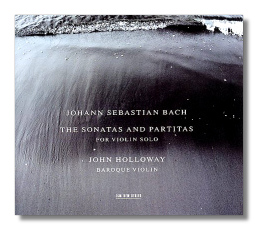
The Internet's Premier Classical Music Source
Related Links
- J.S. Bach Reviews
- Latest Reviews
- More Reviews
-
By Composer
-
Collections
DVD & Blu-ray
Books
Concert Reviews
Articles/Interviews
Software
Audio
Search Amazon
Recommended Links
Site News
 CD Review
CD Review
Johann Sebastian Bach

Sonatas and Partitas for Solo Violin
- Sonata for Violin in G minor, BWV 1001
- Partita for Violin in B minor, BWV 1002
- Sonata for Violin in A minor, BWV 1003
- Partita for Violin in D minor, BWV 1004
- Sonata for Violin in C Major, BWV 1005
- Partita for Violin in E Major, BWV 1006
John Holloway, Baroque violin
ECM New Series 1909/10 DDD 2CDs 64:28, 68:02
Why, I wondered, was ECM New Series releasing a second set of Bach's Sonatas and Partitas for Solo Violin in two years? Gidon Kremer's discs (ECM New Series 1926/27) came out in 2005; why would the label compete with itself in this way?
The answer may lie in the instrumentation. Holloway's instrument is prominently described as a "Baroque violin," while Kremer's is not so designated. In other words, the new recording is meant to cater to the period instruments crowd, while the older one is of more general interest. But not so fast! Going more deeply into it, we read that Kremer's instrument (the songful "Ex-David" Guarneri del Gesù from 1730) actually is older – chronologically more Baroque, if you will – than Holloway's, a violin by Ferdinando Gagliano of Naples, made in 1760. Of course there is more to Baroque performance practice than the age of the instrument, but nevertheless I was interested by this seeming paradox. Suffice it to say that Kremer's performance, despite the age of his instrument, is "new school," whereas Holloway's is most definitely "old school," with plenty of buzz, rasp, and character to the sound, and not much vibrato.
If you'd like to know more about period instruments and performances of Bach's so-called "Sei solo," you might want to purchase the set played by Jaap Schröder, also on Baroque violin. Although released in 2005 by Naxos (8.5575663-64) it actually was recorded in 1984-85. Unfortunately, the provenance of Schröder's instrument is not identified, but I see his set as the real competition to Holloway's, not Kremer's.
It is a difficult choice to make. Holloway treats these works as an authentic religious experience. He forges straight ahead with no-nonsense Lutheran determination, knowing that through hard work, he (and the listener) will come closer to God. Perhaps it is for that reason that he makes no secret of the technical difficulties associated with playing these works on a Baroque violin. His playing isn't effortful, it's just that at many points we are as aware of the technique as we are of the music's intellectual and psychological impact. Schröder's phrasing is more plastic and his viewpoint is more relaxed, and I was not surprised to find that his recording is some ten minutes longer than Holloway's. Schröder also is more traditionally expressive, more willing to dig in to make an interpretive point; Holloway backs away and lets the listener have his or her own thoughts about the music. What many people will love about Holloway's new recording, however, is the sound. He has been recorded at the Propstei St. Gerold, a venue in which his instrument is allowed to echo and re-echo. The sound seems to be going straight up to God Himself… that is, after bouncing around in the church for several seconds! Schröder's version is more objectively recorded (albeit also in a church), with a smaller halo of reverberation around his instrument.
This new release will not disappoint listeners who have enjoyed Holloway's playing in the past, or who appreciate ECM's philosophy in general. It inspired and quieted me. Still, I do not think it tells the whole story. However, whose recording of these always fascinating works does?
Copyright © 2007, Raymond Tuttle




















